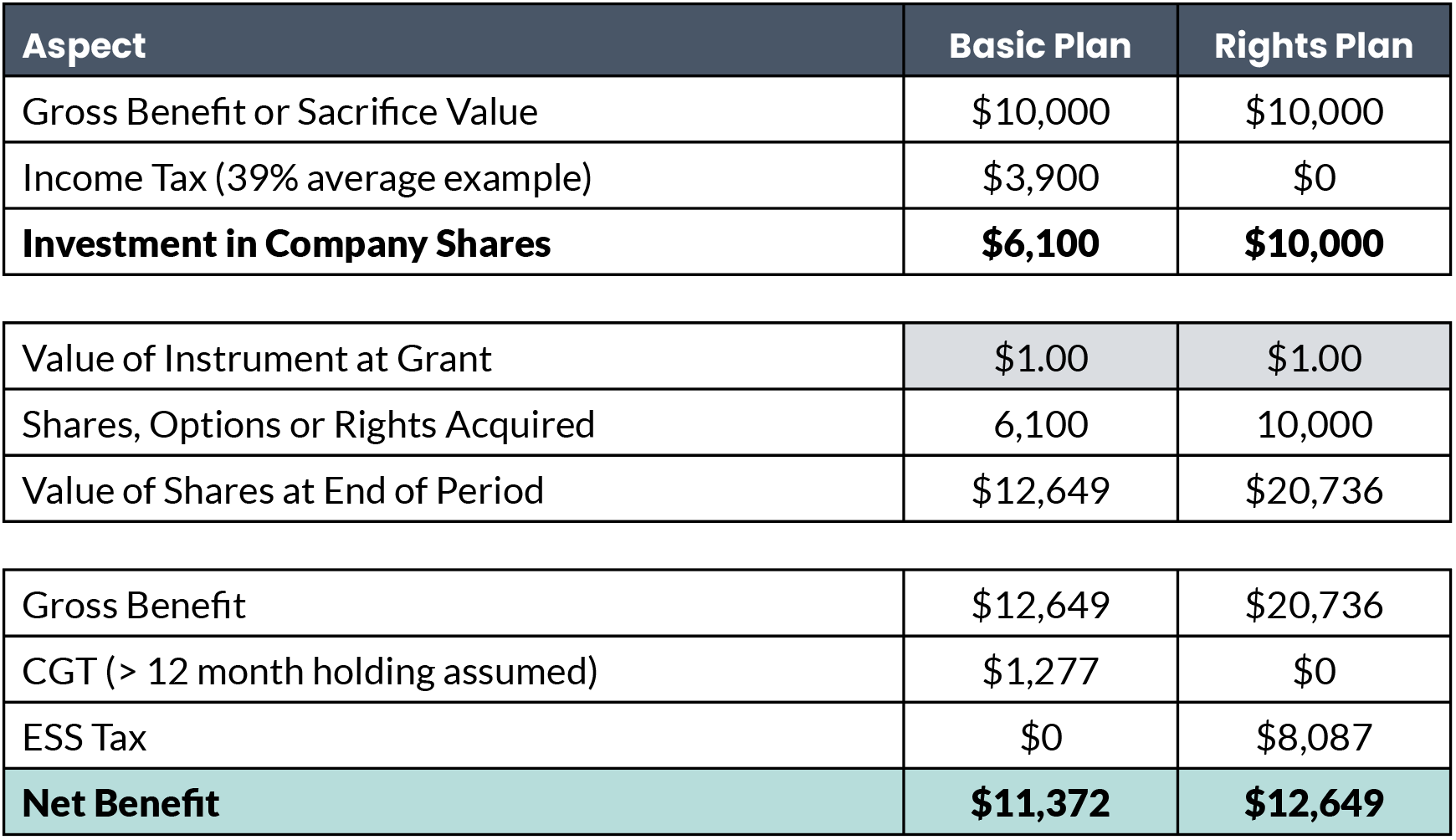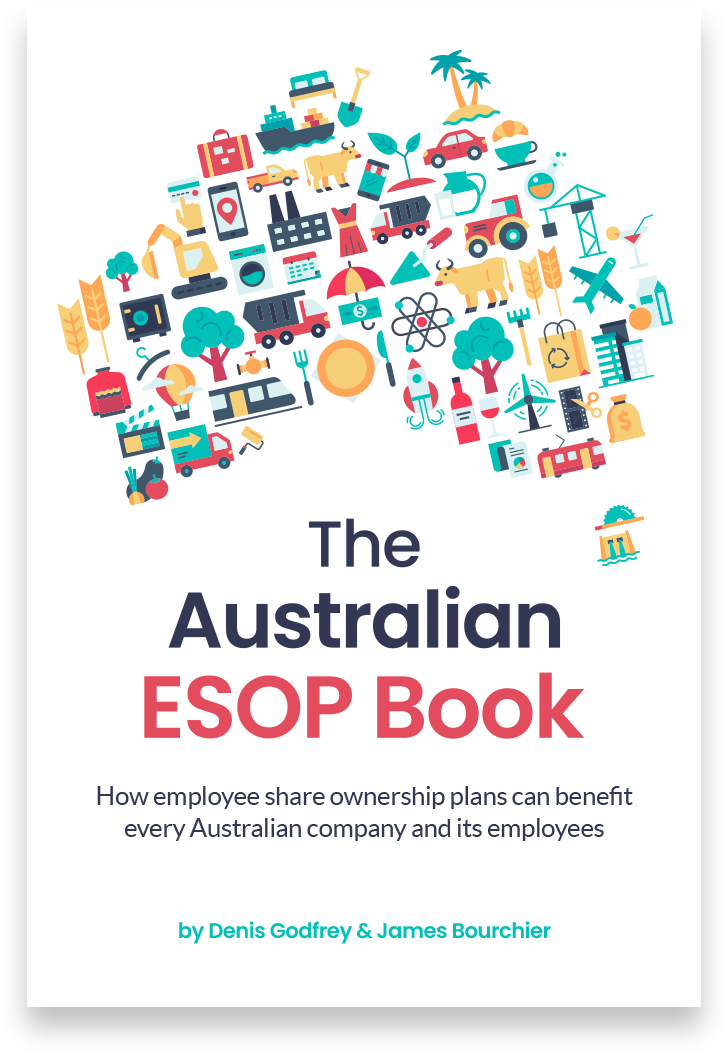Reasons to use ESOPs
- To align stakeholder interests.
- Improved, favourable tax treatment and regulations.
- Can be the cheapest (even nil net cost) and most effective form of remuneration when done correctly.
- Share wealth with those creating it.
- Financial and tax advantages.
- Attract and retain key talent.
- Drive and leverage sustainable growth.
- Can be the most valuable component of remuneration for employees in growing companies.
- Can be the lowest-cost employee benefit if done on a salary sacrifice basis.
- Transition ownership or create a market for founder equity.
- Use as a risk management tool.
Reasons not to use ESOPs
- If not correctly configured, may represent financial risk for employees.
- There are significant tax and legal issues to understand and navigate.
- Highest cost form of remuneration when incorrectly configured.
- Can lead to disengagement, if based on salary sacrifice and the share price falls.
- Some employee groups may be wary of equity if they are not provided with educational resources.
- Unlisted companies without an active market in their shares must buy-back shares or settle equity interests partly in cash to fund tax – can be cash-flow expensive, if not designed to be self-funding.
ESOPs in Australia
Employee ownership has been a well regarded concept for many years in the most successful developed economies, but comparatively, ESOP use in Australia remains low. This is largely due to incompatible tax regulations that were improved in FY16. Legislation was further improved in FY23 under the Corporations Act. The more favourable regulatory and tax environment is expected to lead to greater use of ESOPs in Australia.
So, what is an ESOP and why should Australian companies be introducing them now? Here we discuss both of these questions and also canvass some of the regulatory and tax issues that need to be considered when implementing an ESOP.
To access independent Australian research on ESOPs see Research Paper 4/2017, The Performance and Characteristics of Australian firms with Employee Share Schemes which was released by the Department of Industry, Innovation and Science in July 2017.
What is an ESOP?
An ESOP is a plan that is put in place by a company to:
- facilitate its employees becoming part owners via Share ownership, or
- provide employees with an interest in the business that is equivalent to or simulates the experience of becoming a shareholder. This may or may not involve genuine equity and could be:
- a plan that provides employees with rights to shares if a liquidity event occurs in the future, such as an IPO or trade sale, or
- a “phantom” plan that replicates the wealth opportunity often associated with becoming a shareholder, but without involving actual shares (which may be to limit dilution or control voting parties etc.).
- provide part of variable remuneration, such as short or long term incentives, in the form of equity-related interests, linked to service and/or performance conditions, and/or
- reduce cash-costs by providing part of Fixed Pay in the form of equity-related interests.
As most employees are not in a position to purchase shares in their employer, or do not see it as a priority, ESOPs seek to change that circumstance. This may be achieved in many ways, for example by:
- Providing an easy regular saving mechanism either on an after-tax or before-tax (salary sacrifice) basis to fund Share acquisitions,
- Settling Fixed Pay or short term awards already earned, in equity (i.e. no cost to the employee, and no difference in cost to the employer),
- Providing discounted share prices,
- Providing nil transaction costs and lower minimums for employees when Shares are purchased,
- Providing matching Share acquisitions at nil cost to employees,
- Offering options or rights which may in some circumstances involve discounted or nil/no exercise prices,
- Offering low or nil interest loans to fund Share acquisitions,
- “Gifting” shares as an additional benefit of employment, and/or
- Offering shares or rights as an incentive or award.
Of course, combinations of the foregoing may be used to encourage employees to become shareholders.
Market View
The highest use of ESOPs is in the finance sector – a telling confirmation of their financial benefits for both employers and employees.
Given the often substantial benefits to employers, it is perplexing that only 31% of large listed companies have ESOPs. Perhaps the low level of ESOPs reflects that for historical reasons Australian companies have focussed on plans with high costs of operation or have not appreciated the advantages of having ESOPs that are available under new regulatory frameworks. While in the past equity plan limits of around 5% over 3 years applied to most listed company plans, and much of this was consumed by executive equity arrangements, those limits no longer apply to most plan types.
Employer Perspective – General
There are many reasons for implementing an ESOP including that they can:
- improve productivity from a more engaged and committed workforce who share in the company’s success,
- support risk management and other culture/values behaviours from the bottom up through aligned interests,
- lower turnover and costs associated with recruitment, lost productivity and training,
- reduce labour cost via improving attendance (fewer sickies),
- increase the tax effectiveness of remuneration when provided in tax deferred and/or tax exempt equity (shares, rights or options),
- help make a company an employer of choice as it is seen to be caring for and sharing with its employees,
- reduce the cash outflow of cash remuneration when converted to an issue of shares or other equity interests, and
- improve the company’s financial performance and reducing net employment costs via enhanced tax savings.
Employer Perspective – Succession Planning in Unlisted Companies
Private companies that are family or founder owned often face a unique challenge if an initial public offering or trade sale is not expected, and family members are not ideal candidates for succession to run the business.
In these cases, there may be a possibility for the family to sell down their ownership, or transfer it in lieu of bonuses, over a time period, to senior executives and other employees who wish to continue with the business.
An ESOP can be an approach that provides the funding for employees to purchase ownership of the company over a period of time in a way that meets the needs of both the founders/family and the employees.
Employee Perspective
There are many benefits for employees of participating in an ESOP including:
- They can accumulate an ownership stake in the company for which they work and thereby participate in the company’s success to which they contribute.
- They can accumulate an ownership stake in an affordable way.
- They can add to their income via dividends declared from annual profits.
- They can benefit from growth in value of the company as reflected in growth in its share price.
- They may benefit from taxation concessions that produce greater net of tax benefits than may be achieved from after-tax investments in company shares.
- They can benefit from favourable acquisition prices or matching, or acquire shares by fulfilling conditions that do not involve the employee paying for the shares e.g. via growing the value of the business or meeting certain hurdles.
- In some cases, they may be protected from a fall in the share price – a feature that is not available when shares are acquired with after-tax income.
Company Cost
Company cost is an issue for consideration, however, there are alternatives that do not involve company costs and, in some cases, can produce gains for the company. In this regard, how the benefit is funded is an important consideration. For example, salary sacrifice does not involve any additional cost to the company. Also share price discounts and equity grants do not involve cash flow cost to the company when undertaken via new issues.
In all cases there will likely be administration costs that can be significant if a large number of employees participate. For the best plans, these are offset by financial, tax and/or other gains that produce a net benefit for all stakeholders, including general shareholders.
Accounting Expenses
It should be noted that accounting charges will need to be recognised in the company’s accounts when an ESOP or phantom equity plan is operating. These accounting charges generally arise under AASB2 which deals with share-based payments (including cash-settled equity transactions).
If funding is via salary sacrifice, the salary expense will be replaced by a share-based payment expense and can have no net impact due to the accounting expense.
Taxation
The government has sought to encourage ESOPs via specific taxation concessions that extend the general taxation deferral concession available to employee share schemes (ESSs). The specific taxation concessions include:
- Start-up company tax concession which only applies to unlisted companies that meet specific criteria. This approach provides one of the most favourable tax treatments available to any equity ownership arrangement.
- Tax exemption concession, which is available to listed and unlisted companies, but the exemption is limited to $1,000 for each employee each year and only if a range of requirements are satisfied.
- Tax deferral for salary sacrifice share plans which is available for listed and unlisted companies, but the deferral is limited to a maximum of $5,000 per annum per employee and only if a range of requirements are satisfied.
- General ESS tax deferral which allows for unlimited amounts to be deferred for up to 15 years, in specific circumstances.
A change to the Tax Act means that tax at termination of employment no longer applies, which solves a range of previously challenging issues.
If the $1,000 and $5,000 schemes that have been around since before FY16 do not represent a suitable plan for your business, there are now new opportunities under the general ESS taxation concessions to be explored.
Beware the “CGT Myth”
It should be noted that the impact of “ESS tax deferral” is always equivalent to a 100% Capital Gains Tax (CGT) discount, compared to up-front taxation (Basic Plan) and paying CGT tax on any subsequent gains, as demonstrated in the following:

A lack of understanding of the relativity of these approaches has led to many making decisions based on the assumption that CGT treatment produces a better outcome simply because of the smaller tax bill, ignoring the greater net benefit, which we call the “CGT Myth”.
Avoid breaching the Corporations Act by getting good advice
Many listed and unlisted companies have inadvertently breached the Corporations Act when implementing an ESOP, because appropriate advice on how to comply with regulatory frameworks was not obtained as part of developing the ESOP. While the Australian Taxation Office (ATO) provides some off-the-shelf plans, they do not provide guidance on how to implement the plans in a legally compliant manner, which can be complex, particularly for unlisted companies, potentially leaving them open to being sued by participants or having share transactions cancelled by the Australian Investments and Securities Commission (ASIC).
The provisions of the Corporation Act that affect ESOPs changed in 2022. Some of the key issues to be aware of under the current framework include:
- “Matching” plans operated by listed companies are subject to additional requirements in relation to how employee funds are managed, and their ability to exit the plan,
- Any plans that involve a contribution by an employee, whether it be a purchase price for the equity interest, or an exercise price to exercise the interest, is now considered a “contribution plan” and is subject to additional disclosure and compliance requirements, which are onerous for unlisted companies in particular. This means that option plans should generally be replaced with other plan types.
- The limit on the value of options or other contribution plan structures that can be issued to general employees in unlisted companies has been increased from $5,000 per employee per annum to:
- 20% of the company’s issued shares over 3 years, if the plan is not a contribution plan, and
- around $30,000 per employee per annum (with some wriggle room) if the ESOP is a contribution plan such as an option plan,
- Unlisted companies can now offer the same kinds of financial instruments and advantageous derivatives as listed companies, including Share Appreciation Rights (SARs, which are a superior alternative to options) and indeterminate rights (which solve the tax problem for employee who cannot access tax deferral).
- Contribution plans including option plans and salary sacrifice arrangements in listed companies will be subject to a limit of 5% (of issued shares) over 3 years. Previously this limit applied to most if not all plan types, in aggregate, which severely limited their usage.
Conclusion: configured correctly, ESOPs are effective and sustainable
Equity-based remuneration can be the most effective, lowest cost and highest value remuneration element for both employers and employees, when done correctly. Due to the complexity of legal and tax considerations that employers need to take into account when designing equity plans, many companies do not operate an equity plan. The risks associated with getting the legal and tax aspects wrong, in addition to the risk of a mismatch between the structure selected and the circumstances of the business, can effectively prohibit time-poor organisations from exploring or benefiting from this opportunity. Remuneration Technologies aims to help stakeholders on all sides understand and consider the issues, to assist in selecting an appropriately structured equity plan that has optimised outcomes for all parties. Good preparation can significantly reduce the cost, challenges, risk and complexities of developing an equity plan compared to alternative approaches.





